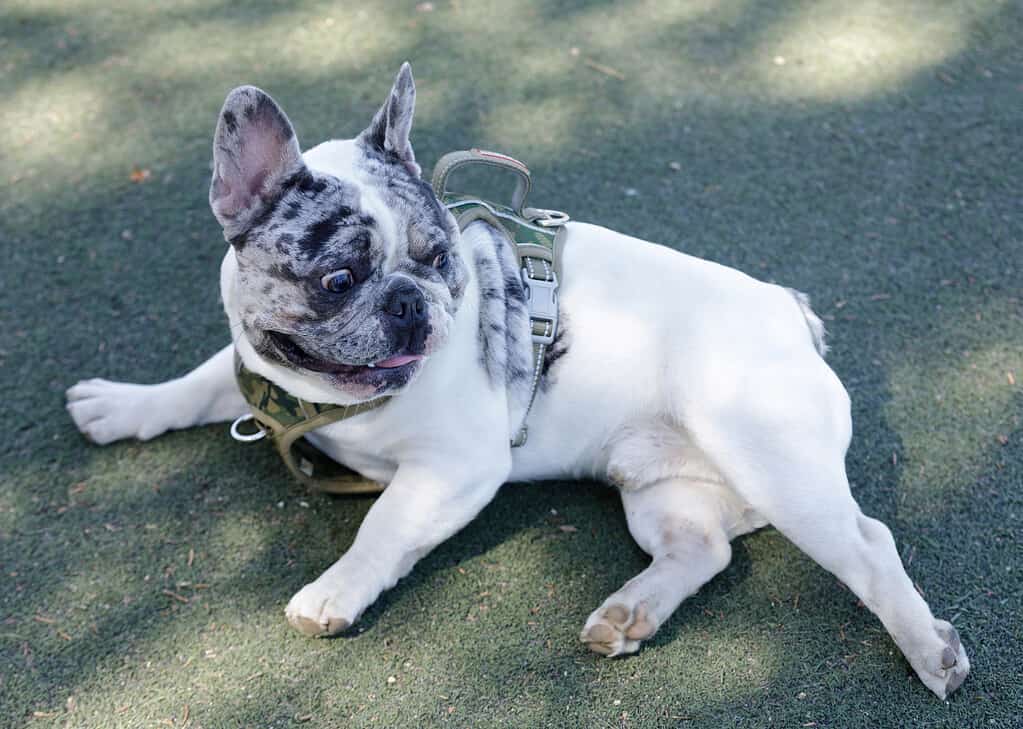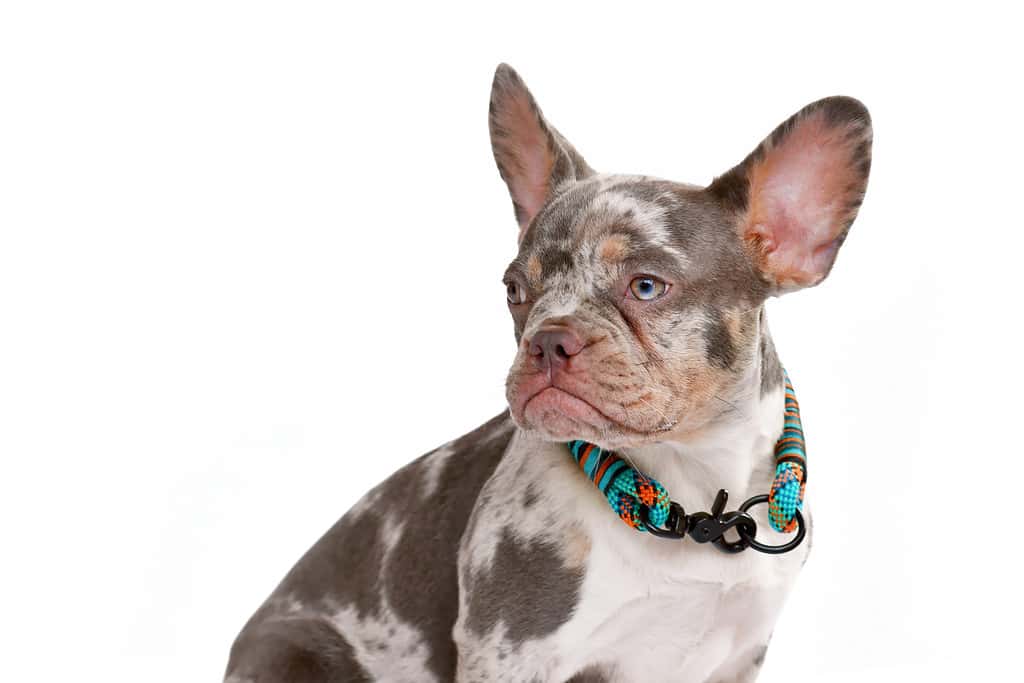A piebald French Bulldog (often called a “piebald Frenchie”) has a mostly white base with patches of another color. The white is typically predominant, covering most of the body. The patches can make up almost 40% of a dog’s coat, or they can make up very little.
The secondary color can be any other color recognized as occurring in French Bulldogs, according to the AKC (which is a lot). The patches of color can appear anywhere, including on the dog’s belly, back, and legs.
While these dogs look different from the typical Frenchie, they have the same characteristics and temperament as any other French Bulldog. They don’t act differently, in other words.
How Rare are Piebald Frenchies?
These canines are considered relatively rare, as this breed has many more common coat colors. Furthermore, the piebald pattern is recessive. Both parents have to carry the trait for their offspring to be piebald.
Because of the very specific genes that are necessary, piebald French Bulldogs are much less common than colors like fawn or brindle. Some breeders do focus on this coloration, though. You’ll often have to go to one of these breeders to find a piebald puppy.
However, breeding for a specific color should be done responsibly and carefully. When you’re aiming to produce puppies with very specific coat genetics, breeders risk not focusing on the breed’s temperament and health, which are arguably more important. Always choose your breeder carefully, but be extra careful when looking for a puppy of a rarer color.
While rarity doesn’t necessarily increase the dog’s value, you’ll often have to pay more for a piebald Frenchie. In many cases, this is due to the higher demand. More people want a piebald French Bulldog than there are available puppies, which drives up the price.
You may also have to sit on a waiting list for longer. After all, piebald Frenchies only appear occasionally in litters, even when purposefully bred for. Therefore, you may have to wait for one to show up if you’re absolutely set on purchasing a piebald puppy.
How Much is a Pied Frenchie?

As you can see, this dog is almost entirely white. However, dogs can still be piebald with more patches than this.
©yhelfman/iStock via Getty Images
As we said above, these dogs often have a higher price tag than other Frenchies. The average French Bulldog costs around $1,500 to $3,000. They are much more expensive than other dogs, largely due to the sudden high demand for this breed. They have recently become very popular, which has led to their price increasing and increasing.
Piebald Frenchies can easily cost around $5,000, though. Their rarity makes them even more expensive. Females are often even costlier, easily reaching the $6,000 range. Quality breeders often charge a lot for their dogs. However, even lower-quality puppy mills are now charging a lot for their Frenchies.
High price doesn’t always equal quality. Be sure to do the proper research before adopting a puppy.
Where to Find a Piebald Frenchie

These canines aren’t known for having more health problems than the typical Frenchie. However, poor breeding can cause health problems to occur.
©Firn/iStock via Getty Images
Finding one can be challenging even if you have the money for one of these dogs. Very few breeders specialize in this coloration; even then, not all of their puppies will have this coloration. If you have specific other traits you want, like gender or temperament, you can expect to have an even harder time finding a puppy that meets all your specifications.
You should be very cautious when purchasing these puppies, as they are prime targets for backyard breeders and puppy mills due to their higher cost. Many people see them as a “get rich quick” scheme.
Always visit the breeder you plan to purchase from and see where the mother and puppies are kept. A breeder that doesn’t let you see the whelping box is a huge red flag. Don’t accept a puppy that is simply “brought in” from the back of the facility somewhere.
You should also ask for health testing results from both the mother and father. Quality breeders will get their parent dogs tested for health conditions to ensure the puppies don’t inherit any health issues. Also, ask for the puppy’s health records thus far. Most puppies will have at least their first round of shots before being sent to their new owners, and all puppies should have had at least one check-up.
The AKC and French Bulldog Club of America recommend specific breeders. Start your search there. All breeders in these organizations have to follow a code of ethics that helps ensure their breeders are not just in it for the money.
The photo featured at the top of this post is © Firn/iStock via Getty Images
Ready to discover the top 10 cutest dog breeds in the entire world?
How about the fastest dogs, the largest dogs and those that are -- quite frankly -- just the kindest dogs on the planet? Each day, AZ Animals sends out lists just like this to our thousands of email subscribers. And the best part? It's FREE. Join today by entering your email below.
Thank you for reading! Have some feedback for us? Contact the AZ Animals editorial team.






